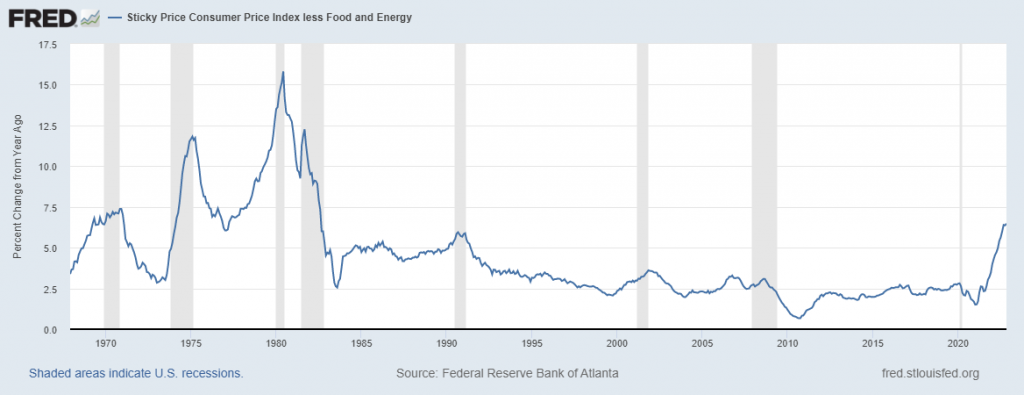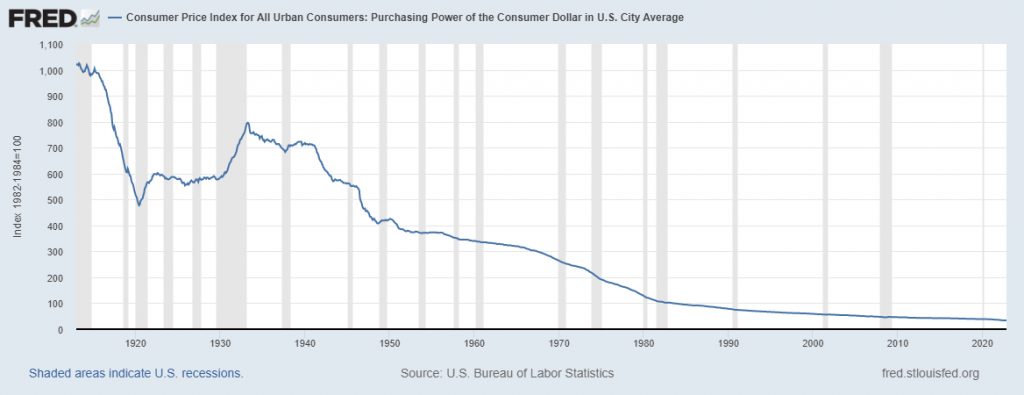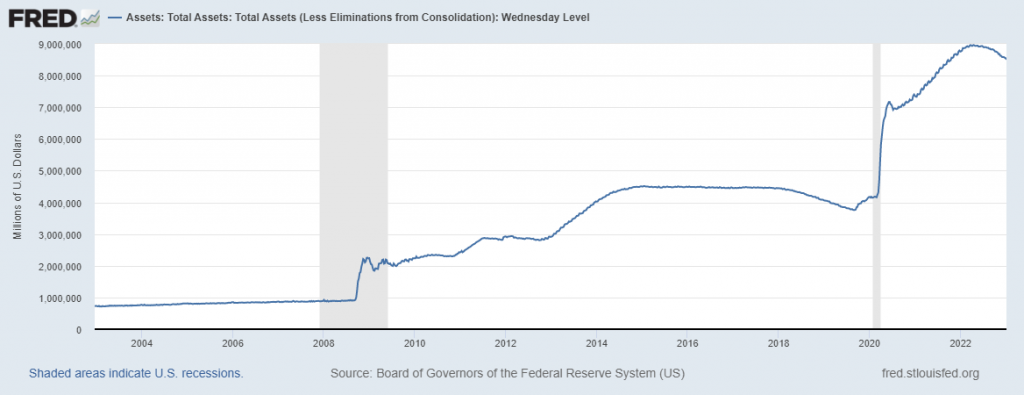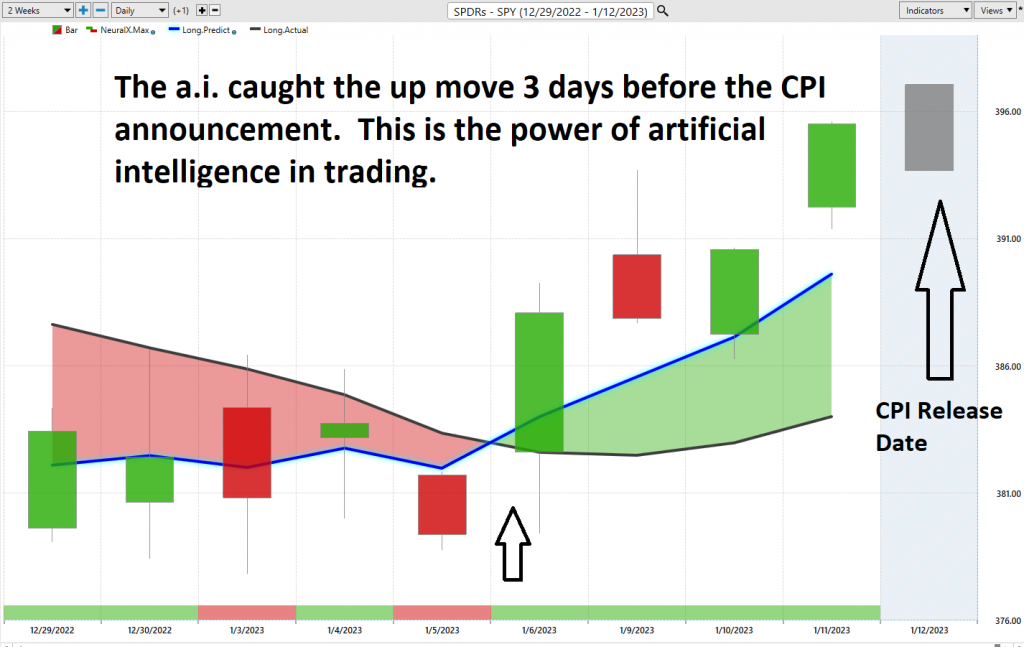Today the Consumer Price Index was released. The report showed a 6.5% inflation rate. As I write these words, a variety of media pundits are hitting the airwaves either attacking or applauding the report. I always find this to be hugely entertaining.
The Consumer Price Index (CPI) was first developed in 1919 by the U.S. Department of Labor. It measures the average changes over time in prices for consumers to purchase a fixed market basket of goods and services typically consumed in urban areas and provides an economic indicator that has become widely used to determine the inflation rate of a given area by comparing current figures with their historical counterparts. The CPI is now regularly updated with new data each month and is used in many applications such as those measuring real wages, government benefits, pensions, capital gains taxes and cost-of-living adjustments tied to social security income. Additionally, CPI data can be collected for a variety of locations globally and complements GDP calculations used to compare countries based on their respective economic production levels over time.
The problem with the CPI report in my opinion is it’s a completely impractical and unrealistic metric. While this may sound harsh the mere fact that food prices and energy prices are removed from the calculation should give anyone who studies the release, reason to question its value and usefulness.

Why is the cost of energy and food not included in the CPI? Because the metric has become highly politicized, and every administration wants to demonstrate that they are not responsible for a deterioration in the standard of living.
Quick question: When you go shopping for anything related to your lifestyle, does a 6.5% increase year over year reasonably simulate your experience?
Whenever I go shopping my experience is that inflation is significantly higher.
Numerous private sector consultants have created flourishing businesses challenging the one-sided nature of government reporting of the Consumer Price Index.
The Chapwood Index is a cost-of-living calculator designed to more accurately reflect people’s real financial expenses in their respective cities. Developed by Ed Butowsky, the index is based off of recent pricing data from 500 goods and services purchased across major U.S. cities. With annual updated figures, the Chapwood Index strives to provide reliable numbers that can better inform people of the true costs of living in different places – something many other calculators seem to be unable to do with accuracy. With this index, people can get a clearer idea of how far money actually goes for them on things like rent and groceries in larger or even smaller metropolitan areas so they can be better informed when it comes to budgeting and planning for their own financial future. I would recommend you bookmark the site and visit it often as its estimates of the cost of living more accurately reflect what is happening in the real economy.
Another alternative to government reporting is Truflation. Truflation is an online service that keeps track of the true cost of living in any given area in the United States. This data is sourced from the Bureau of Labor Statistics and incorporates things like housing prices and cost-of-living across different areas to keep an accurate census on inflation and its impact. The service was founded by Brad Zupp and Dave Olson, who wanted a more accurate way for people to gauge how their paycheck size would be affected by rising costs that weren’t accounted for in traditional cost of living indexes. By accurately listing the definitive price increases, Truflation can help businesses spread out their costs over time to adapt to truflation rates better than adjusting exclusively off CPI estimates.
Last is ShadowStats. ShadowStats provides economic data and analysis which challenges the status quo of government-sanctioned statistics. Founded by John Williams in 2004, ShadowStats shines a light on what they believe to be the true state of US economics and fiscal policy by providing updated versions of long discontinued economic indicators. This can include unemployment, inflation, and consumer confidence. By using publicly available data along with reports from various federal agencies and other institutions, ShadowStats allows their users to view a much different perspective on the economy than what is typically offered. These reporting methods provide invaluable insight into the actual economic and political state of the country which many people turn to in order to make more informed decisions about their finances.
Whenever the CPI is released, I think about the story of Robinson Crusoe and how far we have strayed from understanding that in a healthy economy the prices for all goods and services should consistently fall relative to a stable currency.
Do you remember the story about Robinson Crusoe? Robinson Crusoe is a classic novel by Daniel Defoe that tells the story of a brave and resourceful sailor who survives castaway on a deserted island. Marooned alone, he must find ways to rely on himself to survive the harsh environment and his own loneliness. During his time on the island, he works hard to create shelter and sustenance while still finding ways to enjoy aspects of life such as reading and taking walks to admire nature’s beauty. Through perseverance, Robinson Crusoe eventually rescues another man stranded on the island with him and with this newfound companion finds freedom by building their own boat. The lessons we can learn from Robinson Cruse are strength of will, self-reliance, appreciation of culture, purpose in difficult times, and companionship are powerful healing forces.
Pondering Robinson Crusoe can be an enlightening experience when it comes to understanding economics. When reading this story, readers can envision themselves in similar situations – deprived of the basics of their prior comfort and forced to fend for themselves. It can teach us fundamental lessons in economics such as seeking value for money spent, recognizing opportunity costs, budgeting resources more efficiently and investing wisely. By tracking Crusoe’s journey in accomplishing tasks without modern convenience, we are reminded of the importance of everyday economic decisions that are seen all around us.
But Robinson Crusoe primarily teaches readers about VALUE and Wealth. Any onlooker of the Crusoe economy could quickly understand whether Crusoe’s wealth and standard of living were increasing or decreasing based upon the actions he was undertaking. It is this aspect of the Robinson Crusoe story, specifically defining the improvement of standards of living, that is most memorable and instructive for me.
The compelling story of Robinson Crusoe provides students with an excellent opportunity to learn about economics. First, the concept of scarcity is very clear in the novel, as Crusoe learns that acquiring items essential for survival is not always easy. It emphasizes the idea that he must make smart decisions about his limited resources if he wants to survive and thrive on the island. Further, Crusoe must manage risk and be creative in order to make progress – from preserving food to creating tools from available resources. The novel also introduces students to concepts such as cost-benefit analysis in decision making; for example, should Crusoe prioritize creating shelter first or concentrate on growing food? All these reasons show why this story remains valuable today in teaching modern day concepts of economics.
What the story of Robinson Crusoe teaches us is that whenever technology is introduced to an economy or business the result is always greater productivity and output at a lesser cost. The end result in a healthy economic environment is falling prices for goods and services. Technology always revolutionizes the way we work and increases our efficiency and productivity. Intricate tasks which took days or weeks to complete, but nowadays they can often be accomplished in hours or minutes. Complex manual processes have been replaced with automated systems that allow us to get more done in less time, while cloud computing enables us to access information anytime, anywhere. The possibilities of technology are endless, making it an invaluable asset for increasing efficiency and productivity. But more importantly, is the reality that technology always results in falling costs and prices that consumers pay.
Falling prices should be the norm in a healthy economy.
Price increases in an economy are a common phenomenon that can be attributed to several causes. Often, the rise in prices is caused by an imbalance in supply and demand. When demand increases but supply fails to keep up, it pushes prices up since there is less availability of the goods or services being sought out by consumers. Another factor that can contribute to a price rise is inflation, which occurs when there is too much money chasing too few goods and services resulting in a general increase in prices. Additionally, huge increases in factory costs, such as raw materials and salaries, can lead to higher costs for manufacturers who then increase their prices to try and avoid significant losses. Furthermore, government taxation and levies on essential goods can further add to cost burdens of producers and lead to an overall increase in price levels across an economy.
When prices rise for goods and services in an economic environment that is rich in technology, chances are that the money is broken. In other words, the savings that are being created by technological efficiency are not being passed on in the general economy because the currency is being debased faster than technological advancement is occurring.
Simply study the chart below which represents the purchasing power of the U.S. Dollar relative to the Consumer Price Index. The Dollar is worth 3 cents today versus when the Index was started in 1919!

Historically, the natural tendency in an industrialized market economy with a stable commodity money such as gold has been for general prices to persistently decline as advances in industrial techniques lead to a continual expansion in the supplies of goods.
Stop and think about the implications of this.
When the CPI is reported and pundits are applauding a 6.5% increase in inflation, is that not an admission that as a nation our standard of living has declined by 6.5% year over year?
In a heavily industrialized economy that has been enriched through technology infrastructure over the last 100 years shouldn’t we expect falling prices?
When I purchased my first computer 40 years ago it cost me over $3200, and that computer didn’t even have a hard drive. Today thanks to technological advancement I can purchase a computer with a thousand times more speed and functionality for 10% of the price. Shouldn’t this be the way we define normal?
The primary benefit of the Robinson Crusoe story is that the changes to the standard of living are very black and white and easily understood. Factors that determine a healthy standard of living for people are things like productivity, a stable currency/unit of purchasing power, physical health, quality of the environment, housing availability, life expectancy, personal safety, and access to education, medical facilities, and social services.
But stop and think about what it means when the Consumer Price Index is released, and it is reported that General Prices increased 6.5% year over year?
The spin will tell you that this is a marked improvement from the 9.1% reading which occurred 6 months ago. But how is a decrease of 6.5% in the standard of living a good thing?
A 6.5% increase in inflation means you have to earn at least 6.5% more money just to break even.
Or you have to subtract 6.5% from the return your assets generate to get an accurate picture of your performance in real terms.
More importantly, looking at the CPI report gives every investor and trader the opportunity to question the efficacy of the Fed in managing the economy. The following graphic maintained by the St. Louis Fed shows how in 13 years they have piled $8 trillion on to their balance sheet.
What I find to be most troubling out of reports with the CPI is that numerous mainstream economists have commented that 4% to 6% annualized inflation should be the new Fed target for managing the economy! This is amplified by Fed Chairman Jerome Powell’s recent comments:
“Reducing inflation is likely to require a sustained period of below trend growth. This historical record cautions strongly against prematurely loosening policy. We will stay the course until the job is done.”

The biggest challenge for traders today is simply trying to make sense of it all so that effective trading decisions can be made. In the world of yesteryear, a 6.5% inflation would have been met with horror and stock market contractions. However today the spin doctors are out in full force and the markets have staged an impressive rally over the last few days.
Do I agree with it? Absolutely not.
But don’t let opinions get in the way of good statistically sound trading decisions. Look at the following chart of the $SPY over the last two weeks. The artificial intelligence caught the explosive up move 3 full days before the CPI announcement was made.

In today’s world, artificial intelligence (A.I.) has made amazing advancements that have helped to revolutionize the way we live. From its use in medical testing and diagnosis to providing a greater understanding of transportation and logistics data, A.I. has brought about a more efficient and effective way for people to interact with their environment. Through the development of natural language processing, robots are now able to understand spoken orders and execute them accordingly. Additionally, A.I. is becoming more widely used for facial recognition systems, helping to improve security measures around the world. Lastly, A.I. has allowed us to explore deep learning which can help machines recognize patterns in data and then make decisions based on those patterns. All these accomplishments demonstrate just how far AI has come in such a short period of time.
Artificial intelligence is rapidly revolutionizing the way humans think, interact, and even go about their daily lives. Over the past decade, A.I. has advanced to a point where it can easily digest and analyze large amounts of data at once; this means that A.I. can make well-informed decisions faster than any human being. As a result, many businesses and organizations have begun to take advantage of its potential for handling complex tasks with efficiency and accuracy. A.I. is being used in fields such as healthcare, finance, and robotics. In addition, autonomous vehicles powered by artificial intelligence can detect and avoid obstacles more quickly than people are able to do so manually. We are only beginning to see what A.I. can do – it has become abundantly apparent that it will be a key factor in our advancement into the future as a species.
Traders in the financial markets are constantly dealing with volumes of data to make decisions, and it can be overwhelming. Artificial Intelligence helps take that load off by not only collecting and analyzing data quickly but also predicting future trends and fluctuations. A.I. technology can process vast amounts of frequently updated data more accurately than a human trader ever could, therefore providing insights into trends faster and more reliably. Advanced A.I. algorithms will allow traders to act quickly on potential opportunities while also reducing risk, which is essential for successful trading. In short, traders need artificial intelligence to beat the competition, better predict possible outcomes and trends, as well as reach goals faster and more efficiently.
Keep in mind that artificial intelligence has beaten humans in games like Chess, Poker, Jeopardy and Go. Why should trading be any different?
As A.I.’s capabilities continue to grow, industry experts predict the technology will master ever-increasingly complex tasks that traditionally require human expertise. Therefore, it may only be a matter of time until A.I.’s are better than humans at any given task or game — no matter how challenging it may be for computers to learn and understand them.
What’s Your Best Chance to Make Money in The Financial Markets Today?
The Answer A.I. offers will surprise you.
Today Artificial Intelligence, Machine Learning and Neural Networks are an absolute necessity in protecting your portfolio.
I have an extraordinarily strong opinion that stocks are going to go lower if the Fed follows through on their announcements. But my “NORTH STAR” will always be the trend highlighted by artificial intelligence.
A.I. combined with neural networks are exactly the types of analytical horsepower you need to stay on the right side of the right trend at the right time.
If survival of the fittest makes you uneasy, stay out of this zero-sum game.
Artificial intelligence is so powerful because it learns what doesn’t work, remembers it, and then focuses on other paths to find a solution. This is the Feedback Loop that is responsible for building the fortunes of every successful trader I know.
That should get you excited because it is a game changer!
While reporters, talking heads and analysts want to discuss esoteric economic ideas, my only loyalty as a trader is to the trend! This is how VantagePoint artificial intelligence simplifies and empowers traders daily!
I invite you to learn how to forecast the stock market at our Next Free Live Training.
It’s not magic. It’s machine learning.
Make it count.
IMPORTANT NOTICE!
THERE IS SUBSTANTIAL RISK OF LOSS ASSOCIATED WITH TRADING. ONLY RISK CAPITAL SHOULD BE USED TO TRADE. TRADING STOCKS, FUTURES, OPTIONS, FOREX, AND ETFs IS NOT SUITABLE FOR EVERYONE.
DISCLAIMER: STOCKS, FUTURES, OPTIONS, ETFs AND CURRENCY TRADING ALL HAVE LARGE POTENTIAL REWARDS, BUT THEY ALSO HAVE LARGE POTENTIAL RISK. YOU MUST BE AWARE OF THE RISKS AND BE WILLING TO ACCEPT THEM IN ORDER TO INVEST IN THESE MARKETS. DON’T TRADE WITH MONEY YOU CAN’T AFFORD TO LOSE. THIS ARTICLE AND WEBSITE IS NEITHER A SOLICITATION NOR AN OFFER TO BUY/SELL FUTURES, OPTIONS, STOCKS, OR CURRENCIES. NO REPRESENTATION IS BEING MADE THAT ANY ACCOUNT WILL OR IS LIKELY TO ACHIEVE PROFITS OR LOSSES SIMILAR TO THOSE DISCUSSED ON THIS ARTICLE OR WEBSITE. THE PAST PERFORMANCE OF ANY TRADING SYSTEM OR METHODOLOGY IS NOT NECESSARILY INDICATIVE OF FUTURE RESULTS. CFTC RULE 4.41 – HYPOTHETICAL OR SIMULATED PERFORMANCE RESULTS HAVE CERTAIN LIMITATIONS. UNLIKE AN ACTUAL PERFORMANCE RECORD, SIMULATED RESULTS DO NOT REPRESENT ACTUAL TRADING. ALSO, SINCE THE TRADES HAVE NOT BEEN EXECUTED, THE RESULTS MAY HAVE UNDER-OR-OVER COMPENSATED FOR THE IMPACT, IF ANY, OF CERTAIN MARKET FACTORS, SUCH AS LACK OF LIQUIDITY. SIMULATED TRADING PROGRAMS IN GENERAL ARE ALSO SUBJECT TO THE FACT THAT THEY ARE DESIGNED WITH THE BENEFIT OF HINDSIGHT. NO REPRESENTATION IS BEING MADE THAT ANY ACCOUNT WILL OR IS LIKELY TO ACHIEVE PROFIT OR LOSSES SIMILAR TO THOSE SHOWN.




